Top>Research>Aiming to create objects and sounds with high sensory value
 Index
Index
Aiming to create objects and sounds with high sensory value
Takeshi Toi
Professor, Department of Precision Mechanics, Faculty of Science and Engineering, Chuo University
Areas of Specialization: Acoustics Engineering, Comfortable Sound Design, Smart Sound Design
Unique research which focuses on the five senses to link sounds and objects
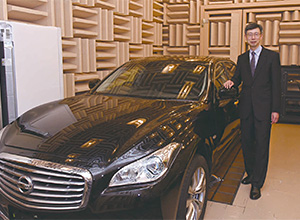
A large-scale semi-anechoic chamber containing two vehicles
Although a quiet environment is preferred in daily life, an environment which is completely devoid of sound is unnatural. People feel unpleasant and uneasy when there is no sound information. In recent years, improvements in the quietness of living environments have exposed small noises which people did not previously notice. This has caused increased interest in sound. Therefore, instead of reducing noise for loud noises which people find annoying, I am conducting research based on a revolutionary idea which I call comfortable sound design. This concept involves designing noise and changing it into sound which is pleasant to the human ear.
When basic performance improves, people begin to focus on sensations which can be evaluated via the five senses. The strong first impression of visual information is well known. However, continual auditory information which does not rely on vision has a huge impact on daily life. In addition to improving the sensory value of industrial goods, comfortable sound design improves spatial value in a variety of sound environments. As a result, this technology is attracting attention from industrial circles.
Promoting joint research through a partnership among industry, academia, and government
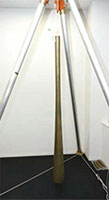
Bell of Sagrada Familia
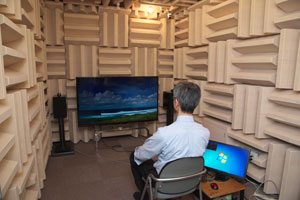
Effectiveness research for high-resolution sound sources
The Sound Control System Laboratory (located on the Korakuen Campus) belongs to the Department of Precision Mechanics in the Chuo University Faculty of Science and Engineering. The laboratory features a full lineup of advanced equipment such as sound measuring devices and simulation software. Examples of facilities include a large-scale semi-anechoic chamber containing two vehicles, two anechoic chambers, a soundproof room, and an experiment room modeled after a residence. A variety of acoustic research is conducted through research projects realized by collaboration among industry, academia, and government. Our laboratory deals with a wide range of research fields related to sound environments spanning from vehicles, home appliances, audio devices and sports equipments to residences and offices. Other research themes include the effect of high-resolution sound sources featuring a high level of sound quality and the relationship between sound and images. The laboratory also uses numerical analysis based on dimensions and materials to predict and auralize the tone generated by the bell of the temple Sagrada Familia, a World Heritage Site in Spain.
Creating value through smart sound design
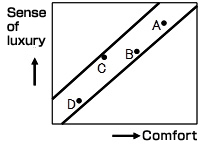
Creating new value through sound quality regulation
Noise control focuses on reducing loud and unpleasant noises as they occur, one after another. As such, noise control only reduces the negative aspects of sound. In order to actively utilize sound as a positive aspect, there is a need for comfortable sound design which creates new value. Also, until now, it was normal to conduct individual design for the mechanical sounds emitted by machines when moving, as well as for electronic sign tones such as notifications and alarms. By including all such factors and performing sound design for the entire system, in addition to simply improving functionality and other engineering aspects, it is possible to realize smart sound design which considers craftsmanship and other artistic aspects.
The figure on the right shows products which have been grouped into grades A, B, C, and D based on requirements for comfort and sense of luxury. By using regulated sound quality for products, it is possible to heighten the quality and identity of products and services, thus contributing to the creation of new value.
Smart sound design: Procedures and sound quality evaluation
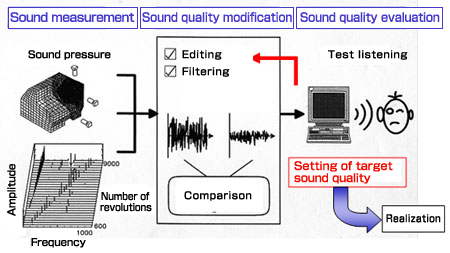
Acoustic simulation for comfortable sound design
The acoustic simulation shown in the figure on the right is used to accurately set sound specifications. The existing sound undergoes temporal editing for aspects such as duration and attenuation. Furthermore, various types of filtering are used to implement frequency changes through signal processing, and the appropriate target sound quality is set through a test listening.
At this time, methods used to evaluate sound quality include the SD (Semantic Differential) method which utilizes several different adjectives and subjective sound quality evaluation based on questionnaires. The questionnaire uses methods such as pair comparison, which involves making judgments by listening alternately to two sounds. Furthermore, although it is possible to ascertain trends in sound by using physical indices, it is difficult to fully express sound by using number alone. Therefore, we also implement objective sound quality evaluation which is based on physiological information such as electrocardiographs and cerebral blood flow. Discrepancies in interpretation of terminology do not manifest in objective sound quality evaluation, and the method can be applied to young children and elderly individuals for whom it is difficult to conduct questionnaire surveys. Another benefit is that objective evaluation can be implemented even when the subject is not consciously assessing the sound quality.
Evaluation is affected by factor including the living environment and the frequency characteristics of language which is normally spoken. For example, recognition during sound quality evaluation differs depending on past experiences and emotional condition. Another example is how onomatopoeias differ between Japanese and English. Furthermore, evaluation may be affected by other sensory information such as visual information. These factors are considered in order to ultimately link and form the sound quality and design parameters for realizing the basic performance and target sound quality.
Resemblance evaluation for vehicle acceleration sound and musical instrument sound
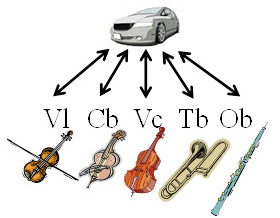
Resemblance comparison between vehicle acceleration sound and musical instrument sound
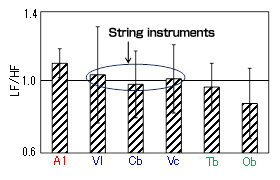
Sound quality evaluation for vehicle acceleration sound and instrument sound based on an electrocardiograph
I would now like to introduce resemblance evaluation for vehicle acceleration sound and musical instrument sound, both of which are classic examples of pleasant sounds. In this evaluation, I used the acceleration sound of five vehicle models (hereinafter referred to as “A1”) which are known for their high-ranking acceleration sound. The musical instruments were played by professional musicians in an attempt to resemble the acceleration sound of a vehicle. As shown in the figure, these five categories of musical instruments were used: three types of string instruments consisting of a violin (V1), a cello (Vc), and a contrabass (Cb), and two types of wind instruments consisting of a trombone (Tb) and an oboe (Ob). Uniform control was implemented for all evaluation sound pressure. Test subjects were 13 people aged 20 to 29.
First, we conducted a subjective sound quality evaluation using the SD method which utilized adjectives. Compared to the wind instruments, the string instruments had a high score for creativity factor. As shown in the figure, the closest impression was between the A1 acceleration sound and the V1 instrument sound. Next, we conducted an objective sound quality evaluation based on physiological information obtained through electrocardiography. The variable LF/HF uses a heart rate variability index to show the balance between parasympathetic nerves and sympathetic nerves in the peripheral nervous system. As shown in the figure, we were able to quantitatively ascertain a comparable stress load between the A1 acceleration sound and the three types of string instruments (V1, Vc, Cb).
Furthermore, from a spectrogram showing changes in time and frequency, we observed striations in the harmonic components of the number of engine revolutions for the A1 vehicle which had a highly-ranked acceleration sound. For V1, which maintained a good balance until a high frequency and left a good impression, there was clarity in the higher harmonics and keynotes for playing scales. We believe that these characteristics were one factor in the resemblance between A1 and V1.

Spectrogram for vehicle acceleration sound and musical instrument sound
Sensory formation considering auditory information and complex stimuli with other senses
In some cases, in addition to auditory information, comfortable sound is also affected by factors such as visual information and the feeling of operation. As such, it is important to accurately assess the contributions of each sensation. Furthermore, by instilling sound with functionality, it is possible to provide a variety of support for human lifestyles.
For example, just as wind-bells create the feeling of coolness in listeners, sound is able to influence emotional and physical conditions. Indeed, by changing the sound made by an air conditioner during operation, it is possible to change sensory temperature in terms of feeling cooler or warmer, or to induce sleep. Another example is how blue lighting is a cold color which creates a feeling of coolness and tranquility, while red lighting is a hot color which creates a feeling of warmth and excitement. These synergistic effects can be used to contribute to the comfort and energy conservation in homes and vehicles. On a different note, the stream of water emitted by bathroom showers must feel comfortable to the bather. By assessing the relationship between the sound of the shower stream and the flow amount, it is possible to realize water saving with a soothing effect on the human body. In this way, comfortable sound design contributes to saving energy and reducing environmental load.

Golf club: Enhanced comfort of sound and vibration at moment of impact
Another example is golf clubs. By analyzing the relationship between the sound of impact and the vibration of impact, it is possible to design optimal shaft vibration and increase the feeling of exhilaration felt by the golfer. In the passenger cabin of vehicles, in response to insufficient or excess acceleration sound emitted from the engine or motor, active sound control can be used to create sound which matches the preferences of the driver. Moreover, in the case of single-lens reflex cameras, it is possible to realize a shutter sound which creates a feeling of high-accuracy by adding functional sound from internal speakers to the sensation of hand-held vibration and the mechanical sounds such as the sound of the shutter opening and closing. Similar to how we add spices to our foods, sound design can be implemented according to personal preferences and product grades.

Sound design using mechanical sound and functional sound
Furthermore, there is also the possibility for improving spatial value realized by creating smart sound spaces. An example of this is the rhythm of cyclic sound emitted during continuous printing by office equipment. By making this rhythm slightly faster than a normal heart rate, it is possible to create a comfortable and functional sound environment which improves intellectual productivity. For vehicles, it is possible to heighten safety and prevent accidents by adding a non-intrusive and highly-stimulating functional sound which prevents careless driving. In this case, different sound environments are required. Specifically, the driver must receive the sound information required for driving, while the front-seat and backseat passengers may be free to enjoy music. In response, we are developing sound partitioning, a technology which uses multiple speakers to realize individual controls for the sound environment in different areas. By applying this technology to household areas such as the living room, dining room, and kitchen, it is possible to construct the required sound environment for each area. For example, sounds environments can be constructed for relaxation in the living room and studying in the dining room.
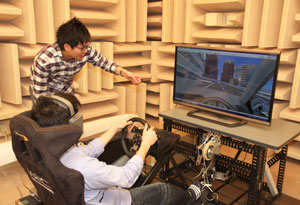
Driving simulator experiment using functional sound
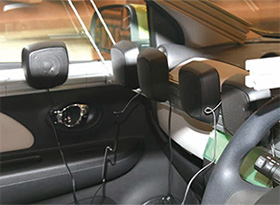
Using multiple speakers to construct a sound partition
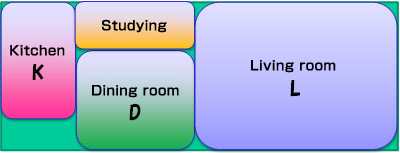
Separation of sound environments in the household areas of living room, dining room, and kitchen
Toward sound trademarks and sound branding
In addition to material sufficiency realized through basic performance, consumers expect products to provide outstanding usability, as well as excitement and empathy through quality which appeals to all five senses. It finally became possible to register sound trademarks in Japan in April 2015, well after similar regulations had been passed in foreign countries in Europe and America. Today, as a means of discernment, sound is being used to produce the feeling of Japanese spirit and the premiere quality of craftsmanship. The delicate and intricate process of sound creation is now moving toward sound branding.
 Takeshi Toi
Takeshi Toi
Professor, Department of Precision Mechanics, Faculty of Science and Engineering, Chuo University
Areas of Specialization: Acoustics Engineering, Comfortable Sound Design, Smart Sound Design- After working as a corporate researcher, Takeshi Toi was appointed as Professor at Chuo University in 2004. He holds a PhD in engineering. He serves as President of the Smart Sound Design Society (SSDS), an association which he founded in 2014 with the goal of constructing comfortable and functional sound environments.
-
Sound Control System Laboratory (Toi Laboratory)
Smart Sound Design Society (general incorporated association) (SSDS)
- Research Activities as a Member of Research Fellowship for Young Scientists (DC1), Japan Society for the Promotion of Science (JSPS) Shuma Tsurumi
- Important Factors for Innovation in Payment Services Nobuhiko Sugiura
- Beyond the Concepts of Fellow Citizens and Foreigners— To Achieve SDGs Goal 10 “Reduce Inequality Within and Among Countries” Rika Lee
- Diary of Struggles in Cambodia Fumie Fukuoka
- How Can We Measure Learning Ability?
—Analysis of a Competency Self-Assessment Questionnaire— Yu Saito / Yoko Neha - The Making of the Movie Kirakira Megane









